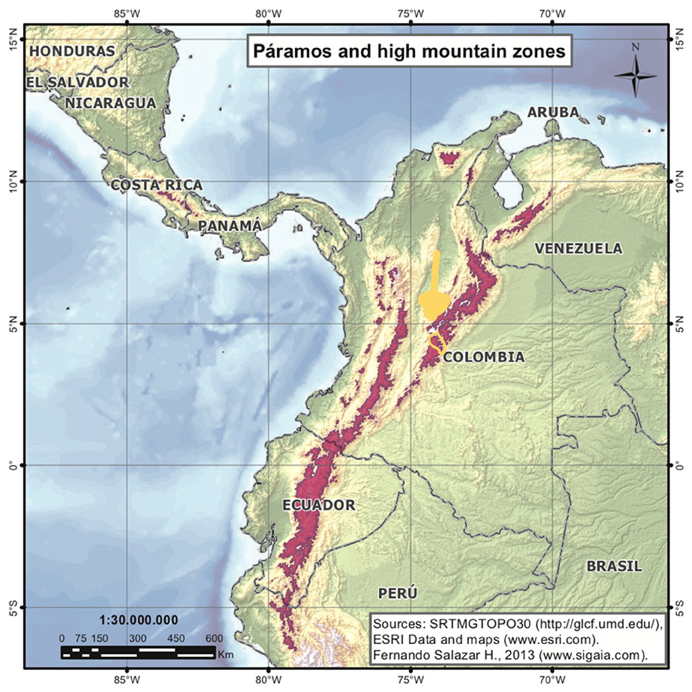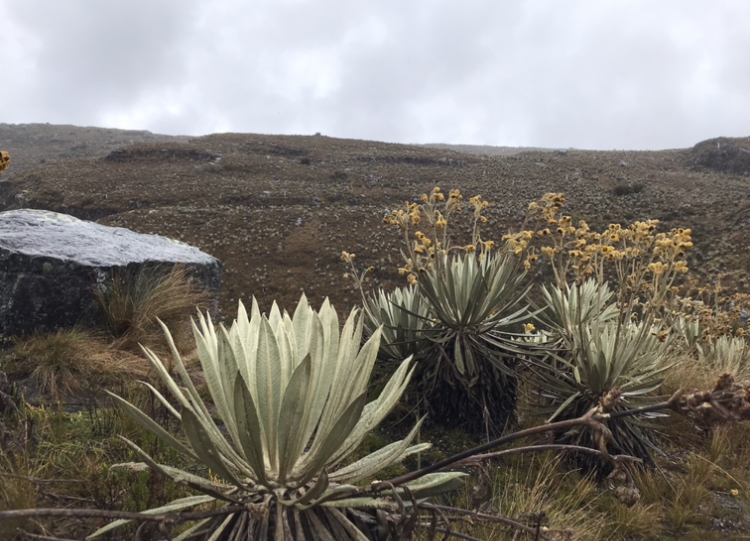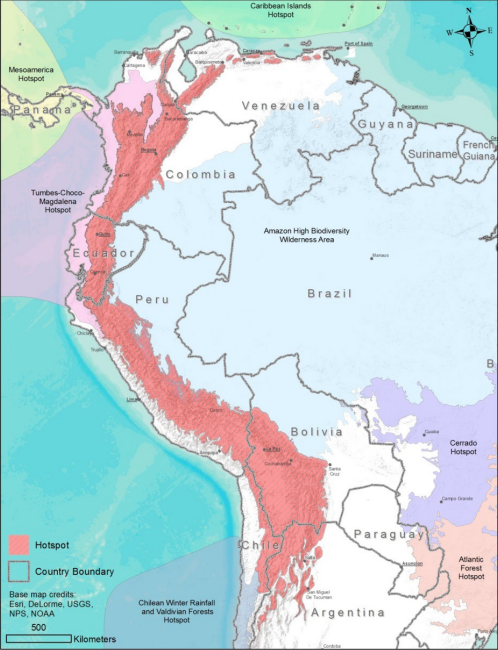Background:
As of today, I have been in the Bogotá area for one week. Despite being a city of 8 million people, I can’t stop running into people I already know. My first day, it was a family I met a few weeks earlier in PNN Tayrona. Yesterday, I met up with Alejandra, a Colombian from Bogotá I met while she was learning English in Austin. Alejandra then introduced me to her friend Jefferson, a bike mechanic and mountain guide. After that, the three of us, along with my travel buddy Gabe, drove up to the Sumapaz Páramo, a massive alpine ecosystem.
About the Sumapaz Páramo:
A páramo is a high-elevation ecosystem found in parts of Venezuela, Colombia, Ecuador, and Perú. They exist in an intermediate zone where it is too cold for forests to grow, yet too warm for snow to accumulate. As a result, the páramo is a world of its own filled with species that can be found nowhere else in the world (1).
A map of the páramos and high mountain zones of the northern Andes. The approximate location of the Sumapaz Páramo is circled in yellow (2).
 Páramo:
Páramo:
Most páramos exist more than 3000 meters above sea level, or nearly 10,000 feet. Here, the weather is always challenging. Most of the time, this means temperatures in the 30’s and 40’s (fahrenheit) and constant clouds and rain. This is the weather I experienced during my time in Sumapaz, and the wet soil and numerous lagunas we encountered reinforced this climate.
Laguna in Parque Nacional Natural Sumapaz.

On our trip, we went to Parque Nacional Natural Sumapaz, or PNN Sumapaz, which protects the Sumapaz Páramo, the largest páramo ecosystem in the world.
Getting There:
We drove to PNN Sumapaz from southern Bogotá in Jefferson’s car.
The Trip:
The drive from Bogotá to PNN Sumapaz was long and led us on a gradual climb up higher into the Andes. During the drive, we passed a series of reservoirs. Jefferson told us that these were created because almost all of the water used in Bogotá comes from the páramos of Guerrero, Chingaza, and Sumapaz (3). In fact, the Sumapaz Páramo is so important to the water supply in Bogtá that PNN Sumapaz was created to protect the city’s water supply. In addition, two important rivers in Colombia, the Río Pilar and Río Sumapaz also begin in the Sumapaz Páramo (4).
Páramos are an important source of water for two reasons.
Firstly, they get a lot of rain. Most páramos in Colombia get over 2 meters of rain every year and have an average humidity of over 70% (1). For reference, the notoriously rainy U.S. city of Seattle gets less than just 1 meter of rain per year (5).
The second reason páramos are an important source of water is how they modulate the flow of water. The spongy páramo soil and numerous lagunas store large amounts of water to ensure a constant outflow of water during times of drought (1, 6). Those who read my post on Monterrey, Mexico will realize this is similar to the role the Sierra Madre Oriental plays in that city’s water supply. It seems people around the world depend on healthy mountain ecosystems to maintain their water supply!
Eventually, we entered the park and went for a walk on its dirt road. Around us were a number of plants that looked like nothing I had ever seen before (and I had seen a lot of plants). Jefferson told me that each of those plants was a frailejón (pronounced fry-lay-hone), a plant which is considered a national treasure of Colombia.
Frailejones in PNN Sumapaz.

Frailejones are one of the many plants specifically adapted for life in the páramo. They can be found only in páramos and nowhere else in the world, and their unique appearance serves specific survival purposes.
Their dense and leafy form helps to insulate the stem against the cold weather in the páramo (7). Freezing and snowy weather are not uncommon here, and the thick leaves are to the frailejones what my jacket was to me (4). But the temperature can climb quickly when the sun comes out, as the only thing brighter than the sun at the equator is the sun in the mountains on the equator. When that happens, the hairs on the leaves that give them their silver coloring protect the plant from getting sunburned (1).
Even for a frailejón, however, life in the páramo is challenging. Due to the year-round cold weather, Jefferson said that these plants only grow about a centimeter per year. This meant that all of the frailejones in Sumapaz were far older than any of us. And these plants were just a sliver of what the páramo has to offer, as it is full of plants found nowhere else in the world.
The tropical Andes, the name given to all elevations of the Andes in Venezuela, Colombia, Ecuador, Peru, and Bolivia, are considered the world’s greatest biodiversity hotspot. They contain one-sixth of all plant species found on Earth, a greater fraction than any other region (8).
The tropical Andes, home of one-sixth of the Earth’s plant species (8).

And in addition to sitting at the literal top of the tropical Andes, the páramo also ranks at the top of all the ecosystems in tropical Andes in biodiversity. One paper referred to the páramo as a “[biodiversity] hotspot within a [biodiversity] hotspot.” The main reason for the páramo’s biodiversity is that it is the fastest-evolving region in the world. In other words, new species are evolving in the páramo more rapidly than anywhere else in the world, creating enormous biodiversity (2).
Although scientists have not yet figured out why páramo species evolve so quickly, they believe it is related to the unique environment found high in the Andes. Possible explanations include the intense UV light in the mountains causing DNA to mutate more quickly or the great distances between individual páramos causing disconnected populations of the same species to differentiate from each other. Neither of these explanations have yet to be proven scientifically (2).
It did not take much time in PNN Sumapaz to realize it is meant to be paradise for frailejones, not people. The park does not allow camping, has just a few, unmarked hiking trails, and no official guided tours. While other páramos are much more tourist-friendly, it is clear that Sumapaz wants to be left in peace. So after walking around for a while, the group decided we had our fill of being cold and wet, and made the trip back to Bogotá.
Until next time, Sumapaz.

Sources:
- M. Fica, Páramo Ecosystem. Missouri Botanical Garden, (available at http://www.mobot.org/mobot/research/paramo_ecosystem/introduction.shtml).
- S. Madriñán, A. J. Cortés, J. E. Richardson, Páramo is the world’s fastest evolving and coolest biodiversity hotspot. Front. Genet. 4, 192 (2013).
- Información básica. acueducto, (available at https://www.acueducto.com.co/wps/portal/EAB2/Home/ambiente/agua/informacion-basica/!ut/p/z0/fYw9C8IwFAD_SpfM77VocdUs4qBWEdq3lBcNIRqTfiTizze4uDnecRwQtECeX9ZwtMGzy9xR3deNxHKF1R4XlcTmfNycDhe5LZcIO6D_QT7Y-zjSGugafNTvCO0QpsjOT_3X-NjrWWCaE082COSnsllqgdoVbBIXjpV2P7zpQgUTIsPwoO4DTgDRBw!!/?1dmy&urile=wcm%3Apath%3A%2FPortalNR_Content_ES%2FUsuario%2FAmbiente%2FEl%2Bagua%2BLabel%2FEl%2Bagua%2Bde%2BBogota%2F).
- Snow falls on Colombia’s high-altitude Sumapaz. The City Paper Bogotá (2022), (available at https://thecitypaperbogota.com/big-picture/snow-falls-on-colombias-high-altitude-sumapaz/).
- Seattle, Washington Climate – 98101 Weather, Average Rainfall, and Temperatures, (available at http://www.worldclimate.com/climate/us/washington/seattle).
- M. F. C. Agudelo, “Ecohydrology of paramos in Colombia:” (Universidad Nacional de Colombia, 2016), (available at https://repositorio.unal.edu.co/bitstream/handle/unal/59136/39177361.2016.pdf?sequence=1).
- L. P. Eraso-Puentes, y. Á. R. Amarillo-Suárez, Arthropods in necromass of two rosette plants species in different successional stages of Andean Páramo. Revista Colombiana de Entomología. 42, 81–90.
- M. Zador, B. E. Young, C. Josse, M. Stern, S. Vasconez, J. Olander, R. Smyth, M. Zador, A. S. de Lozada, P. J. Comer, K. Moull, M. Echavarría, J. Hak, “Tropical Andes Biodiversity Hotspot” (Critical Ecosystem Partnership Fund), (available at https://www.cepf.net/sites/default/files/resources/Donor%20Council/TropicalAndes_EcosystemProfile_TechnicalSummary_DonorCouncil.pdf).
- N. Myers, R. A. Mittermeier, C. G. Mittermeier, G. A. da Fonseca, J. Kent, Biodiversity hotspots for conservation priorities. Nature. 403, 853–858 (2000).

1 thought on “A Day Trip to the Sumapaz Páramo”